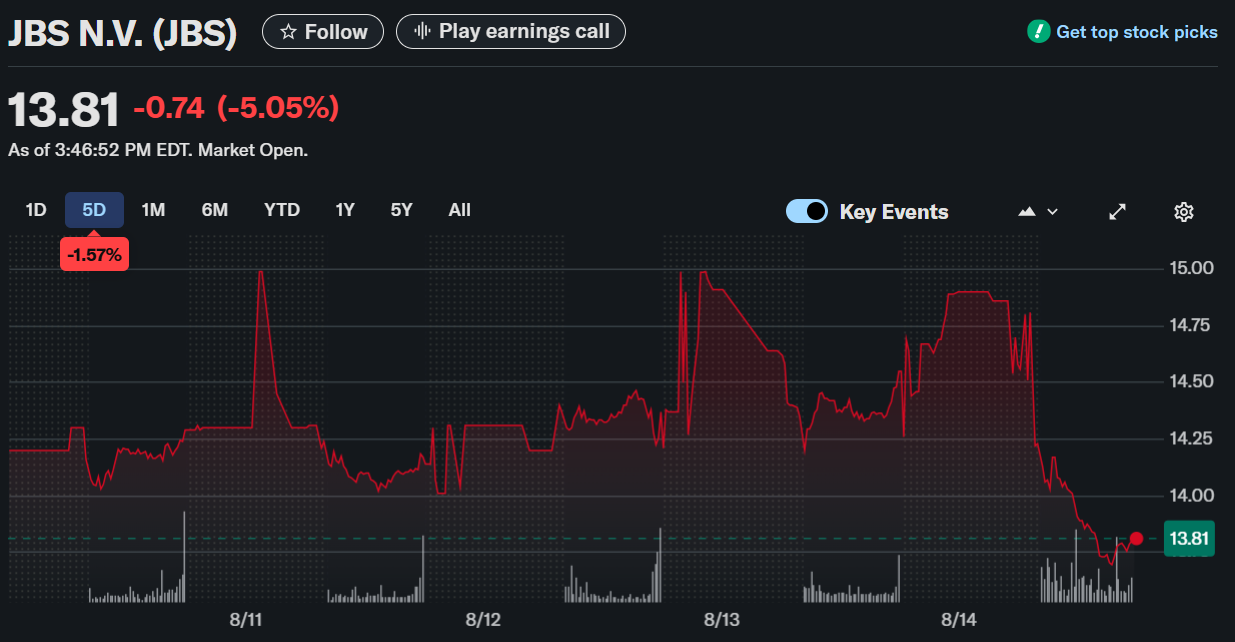TLDR
- JBS N.V. stock fell 5.6% to $13.74 on Aug. 14, 2025, despite announcing a $400M buyback.
- Q2 2025 earnings showed net income growth but deep North American beef losses.
- Dual-listing on NYSE/B3 expands global capital access and lowers financing costs.
- Pilgrim’s Pride delivered record chicken earnings as beef margins faced pressure.
- $200M beef plant upgrades and a $100M ready-to-eat bacon facility aim to boost margins.
JBS N.V. (NYSE: JBS) traded at $13.74, down 5.60% as of 1:49 p.m. EDT on August 14, 2025, even after announcing a significant $400 million share repurchase program.

The Q2 2025 results, released shortly after its dual-listing on the New York Stock Exchange and Brazil’s B3 in June, revealed mixed fortunes: solid overall net income growth, but a widening loss in the company’s largest segment, North American beef.
$400M Buyback: Signaling Confidence
The buyback is designed to boost earnings per share (EPS) and signal management’s confidence in the company’s valuation. With $3 billion in liquidity and a leverage ratio of 2.27x, JBS plans to execute the program while keeping its leverage below 2.5x. CEO Gilberto Tomazoni described the buyback as an “efficient use of excess cash,” leveraging the company’s global access to capital through its dual-listing.
The program follows a $1.2 billion dividend payout in Q2, highlighting JBS’s commitment to shareholder returns. By reducing the share count, the company aims to strengthen its per-share profitability metrics even amid sector volatility.
Dual-Listing Strategy and Capital Flexibility
JBS’s dual-listing offers expanded access to institutional investors and reduced financing costs. The structure includes Class A shares on the NYSE with one vote each, and Class B shares with 10x voting rights for controlling shareholders. This arrangement preserves strategic control while enabling global capital raising. CFO Guilherme Cavalcanti noted the listing “strengthens JBS’s ability to finance growth at a lower cost,” a key enabler for initiatives like the buyback.
Earnings Performance: Beef Struggles, Chicken Shines
Q2 adjusted EBIT fell 12% year-over-year to $1.2 billion. The North American beef unit posted a $293 million loss, an 11-fold increase from the prior year, as the U.S. grappled with its smallest cattle herd in decades. Record slaughter-weight cattle prices have pressured margins across major U.S. meat producers, with tight supplies expected to persist for years.
Pilgrim’s Pride, JBS’s U.S. chicken business, delivered record quarterly earnings, benefiting from strong demand for lower-cost protein and reduced feed costs. Australian beef operations also performed well due to ample cattle availability. However, U.S. pork revenues fell amid high hog prices and Chinese tariffs.
Strategic Investments in Value-Added Products
To offset commodity volatility, JBS is investing in higher-margin, value-added products. The company will spend $200 million upgrading beef plants in Texas and Colorado and has agreed to acquire an Iowa facility for $100 million to become its largest U.S. ready-to-eat bacon and sausage plant.
Financial Snapshot and Outlook
Q2 net income rose to $293 million, or $0.48 per share, from $0.30 a year earlier, beating analyst estimates. Cash burn of $55 million reflected higher inventories in the U.S. and Seara’s Brazilian chicken operations, the latter impacted by trade bans following a bird flu outbreak.
For investors, JBS offers a blend of strong liquidity, strategic capital access, and global protein market leadership. Cyclical risks in the beef sector and ongoing trade challenges warrant close monitoring as the buyback unfolds.






